레이저 녹 제거의 과학
레이저 녹 제거는 마법이 아니지만, 놀라울 정도로 정밀합니다. 이 기술은 집중된 빛 에너지를 사용하여 기본 재료를 손상시키지 않고 녹을 제거합니다. 이는 샌드블라스팅이나 화학 처리와 같은 전통적인 방법에 비해 상당한 개선을 이루었습니다. 이러한 전통적인 방법은 마모성이 있고 환경에 해로울 수 있습니다. 그렇다면 이 과정은 어떻게 작동할까요?
레이저 녹 제거 작동 원리
핵심 원리는 레이저와 녹의 상호작용에 있습니다. 레이저는 특정 파장에서 짧고 강력한 빛 에너지의 펄스를 방출합니다. 녹은 이 빛을 흡수하여 빠르게 가열되고 증발하여 기체로 변합니다. 기저 재료는 반사율과 흡수 특성이 다르기 때문에 대부분 영향을 받지 않습니다. 이는 주변 식물을 방해하지 않고 잡초를 정밀하게 제거하는 것과 유사합니다.
파장과 전력: 정밀도의 열쇠
두 가지 중요한 요소가 레이저 녹 제거의 효과를 결정합니다: 파장과 전력. 다양한 재료는 서로 다른 파장을 다르게 흡수합니다. 적절한 파장을 신중하게 선택함으로써 레이저는 녹을 특정적으로 타겟팅할 수 있습니다. 일반적인 예로는 1064nm 파장의 파이버 레이저가 있으며, 이는 금속에서 녹을 제거하는 데 매우 효과적입니다. 반면에 전력은 속도와 효율성에 영향을 미칩니다. 더 높은 전력 수준은 더 두꺼운 녹 층을 더 빠르게 제거하지만, 손상을 방지하기 위해 신중한 제어가 필요합니다. 이 자료가 도움이 될 수 있습니다: 레이저 통찰력 및 기타.
재료 상호작용 및 응용
레이저의 물질과의 상호작용은 물질의 특성에 따라 달라집니다. 서로 다른 금속과 합금은 레이저 에너지에 다르게 반응하므로 레이저 매개변수를 조정해야 합니다. 예를 들어, 알루미늄과 강철은 서로 다른 레이저 설정이 필요합니다. 이러한 정밀한 제어 덕분에 레이저 녹 제거는 섬세한 복원에서 중장비 산업 청소에 이르기까지 다양한 재료와 응용 분야에 사용될 수 있습니다. 게다가, 레이저 기술의 발전으로 이제는 표면 준비, 페인트 제거, 심지어 마킹까지 가능해졌습니다.
효율적이고 환경 친화적인 솔루션에 대한 수요가 레이저 녹 제거 시장의 성장을 이끌고 있습니다. 2024년 이 시장의 가치는 약 2억 달러로 평가되었으며, 2033년까지 4억 5천만 달러에 이를 것으로 예상됩니다. 이는 2026년부터 2033년까지 예상되는 CAGR 9.5%를 나타냅니다. 이러한 성장은 자동차 및 항공우주와 같은 산업에서 정밀하고 비마모성 표면 처리가 필요한 수요 증가를 반영합니다. 이 시장 성장에 대해 더 알아보려면 여기를 클릭하세요.
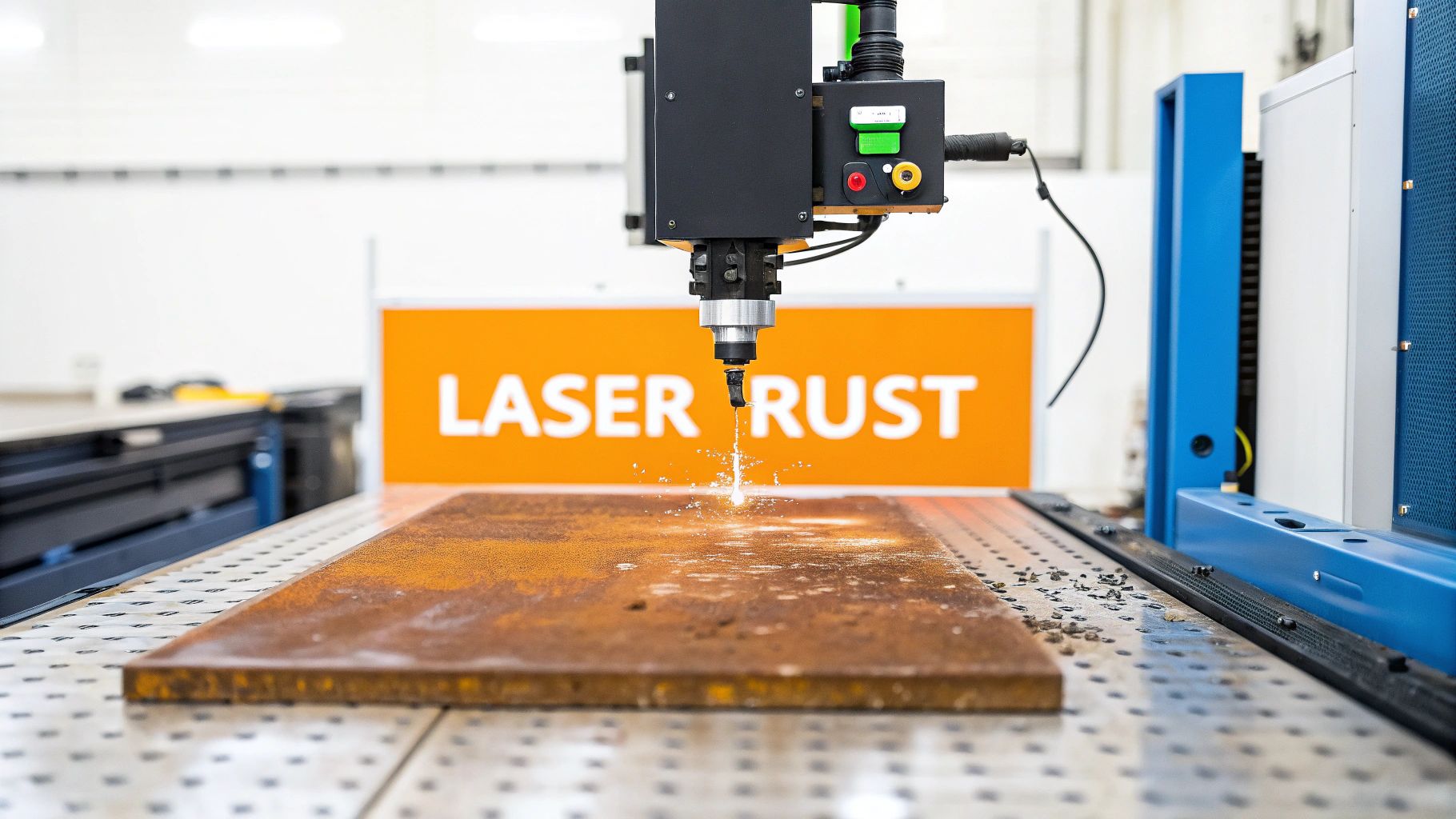
녹 제거의 미래는 확실히 레이저 기술에 초점을 맞추고 있습니다. 이는 전통적인 방법의 한계를 해결하면서 더 깨끗하고, 더 효율적이며, 더 다재다능한 솔루션을 제공합니다. 레이저 기술이 계속 발전함에 따라, 우리는 더욱 혁신적인 응용 프로그램과 다양한 분야에서의 넓은 채택을 기대할 수 있습니다.
레이저 녹 제거가 다른 모든 방법보다 우수한 이유
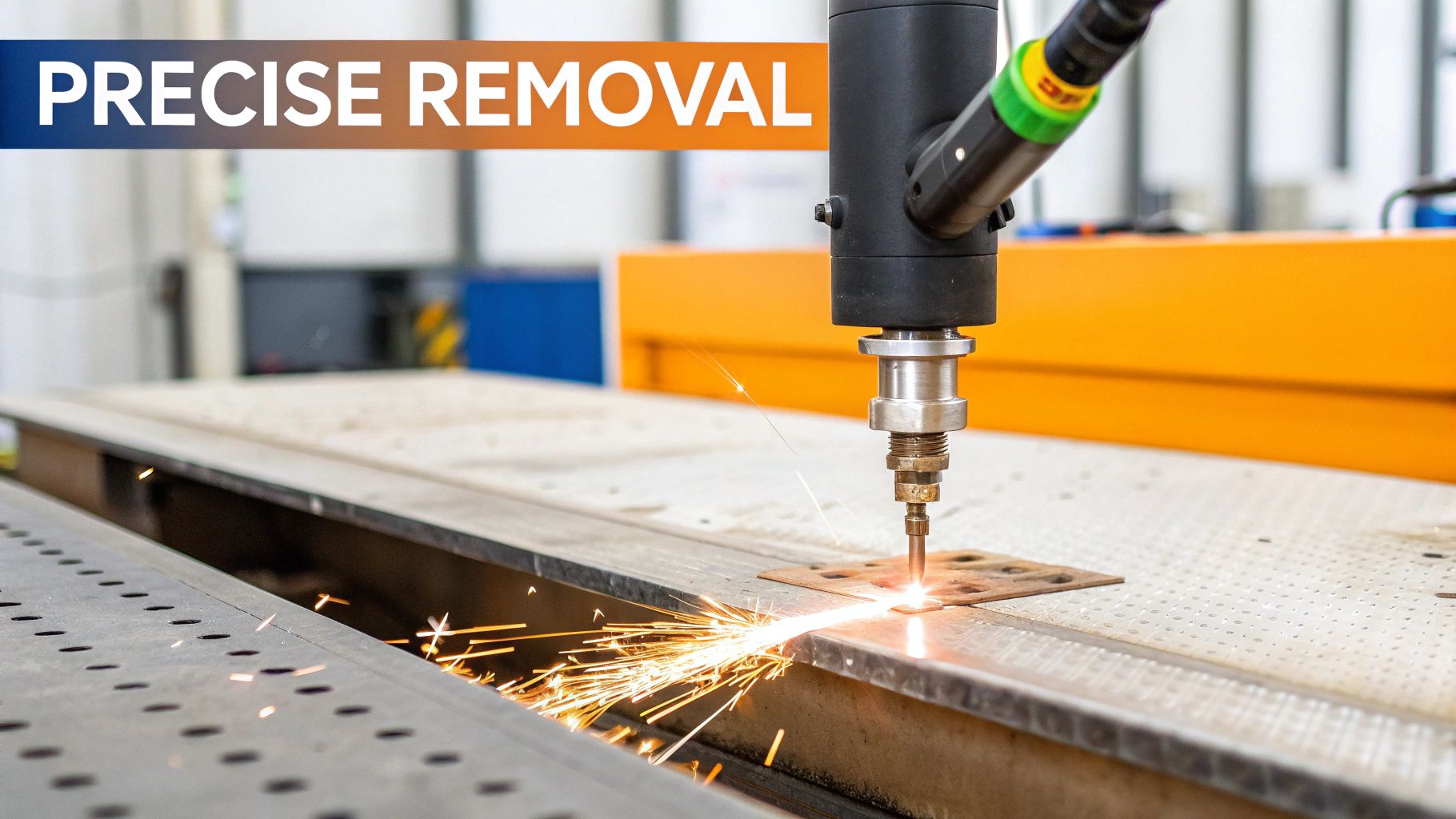
전통적인 녹 제거 방법은 종종 부족합니다. 이 방법들은 지저분하고, 부정확하며, 환경과 작업자에게 잠재적으로 해로울 수 있습니다. 레이저 녹 제거는 매력적인 대안을 제공하며, 품질과 효율성을 크게 향상시키는 정밀도와 제어 수준을 제공합니다.
정밀도와 품질: 명확한 이점
레이저 녹 제거의 가장 중요한 장점 중 하나는 정밀성입니다. 기본 재료를 침식할 수 있는 연마 분사와 달리, 레이저는 오직 녹에만 집중합니다. 이러한 표적 접근 방식은 재료 손실을 최소화하고 기본 표면의 무결성을 유지합니다.
고전 자동차를 복원하는 것을 상상해 보세요. 샌드블라스팅은 섬세한 부품을 손상시킬 수 있지만, 레이저는 주변 금속에 영향을 주지 않고 정확하게 녹을 제거합니다. 이러한 정밀함은 더 높은 품질의 결과를 가져오고 재작업의 필요성을 줄입니다.
환경 및 안전 이점
전통적인 방법은 종종 강한 화학 물질을 포함하여 위험한 폐기물을 생성합니다. 레이저 녹 제거는 훨씬 적은 폐기물을 생성하고 이러한 유해 물질을 피합니다. 이는 근로자와 환경에 더 안전한 선택이 됩니다.
이 과정은 놀라울 정도로 깨끗합니다. 녹이 기화되기 때문에 먼지와 잔해가 최소화되어 청소 시간과 비용이 줄어듭니다. 전통적인 방법은 종종 시끄러운 소음과 진동을 동반하여 작업자의 안전에 위험을 초래합니다. 레이저 녹 제거는 훨씬 조용하고 진동이 적어 보다 안전하고 편안한 작업 환경을 만듭니다.
비용 절감 및 ROI
레이저 녹 제거 장비에 대한 초기 투자는 더 높을 수 있지만, 장기적인 비용 절감 효과는 상당합니다. 인건비 절감, 최소한의 청소, 그리고 자재 낭비 감소는 투자 수익률(ROI)을 더 빠르게 회수하는 데 기여합니다. 향상된 정밀도와 품질은 또한 불량 부품과 재작업을 줄여 비용 효율성을 더욱 높입니다.
레이저 기술이 더 넓은 녹 제거 시장에 미치는 영향을 이해하기 위해 몇 가지 주요 데이터를 살펴보겠습니다. 화학적 및 기계적 방법을 포함한 녹 제거 시장은 2024년에 5억 5,119만 달러로 평가되었습니다. 2032년까지 거의 7억 8,927만 달러에 이를 것으로 예상되며, 연평균 성장률(CAGR) 4.59%로 성장할 것입니다. Stellar Market Research는 이 성장하는 시장에 대한 추가 통찰력을 제공합니다. 레이저 채택의 주요 원동력 중 하나는 부품의 수명을 최대 30%까지 연장할 수 있는 능력으로, 상당한 비용 절감으로 이어집니다.
레이저 녹 제거와 전통적인 방법을 좀 더 자세히 비교해 보겠습니다:
주요 차이점을 더 잘 설명하기 위해, 다음 표는 레이저 녹 제거와 다른 일반적인 방법을 비교합니다:
레이저 대 전통적인 녹 제거 방법
| 요인 | 레이저 제거 | 화학 처리 | 샌드블라스팅 | 기계적 제거 |
|---|---|---|---|---|
| 정도 | 매우 높음 | 낮음~보통 | 낮은 | 보통의 |
| 표면 손상 | 최소 | 식각 가능성 | 마모의 높은 위험 | 긁힘 가능성 |
| 환경 영향 | 낮음 (화학물질 없음) | 고농도 (화학 폐기물) | 중간 (먼지, 매체 폐기) | 낮음~보통 |
| 근로자 안전 | 높은 | 중간 (화학 노출) | 낮음(소음, 먼지) | 보통의 |
| 비용(초기) | 높은 | 낮은 | 보통의 | 낮은 |
| 비용(장기) | 낮은 | 보통의 | 높은 | 보통의 |
| 속도 | 중간 ~ 높음 | 느리다에서 보통이다 | 보통의 | 느린 |
표에서 보여주듯이, 레이저 녹 제거는 정밀성, 표면 보존 및 환경 영향에서 상당한 이점을 제공합니다. 초기 투자 비용이 더 높을 수 있지만, 특히 자재 손실 감소와 부품 수명 증가와 같은 장기적인 이점은 재정적으로 합리적인 선택이 됩니다.
경쟁 우위를 위한 운영 혁신
레이저 녹 제거는 단순한 새로운 도구가 아니라 변화를 의미합니다. 효율성을 개선하고, 폐기물을 줄이며, 품질을 향상시킴으로써 기업은 상당한 경쟁 우위를 확보하게 됩니다. 환경 친화적인 솔루션을 제공할 수 있는 능력은 고객에게 점점 더 가치 있게 여겨지며, 이는 시장 위치를 더욱 강화합니다. 궁극적으로, 레이저 녹 제거는 기업이 보다 지속 가능하고, 효율적이며, 수익성 있게 운영할 수 있도록 합니다.
산업 리더들이 레이저 녹 제거를 활용하는 방법
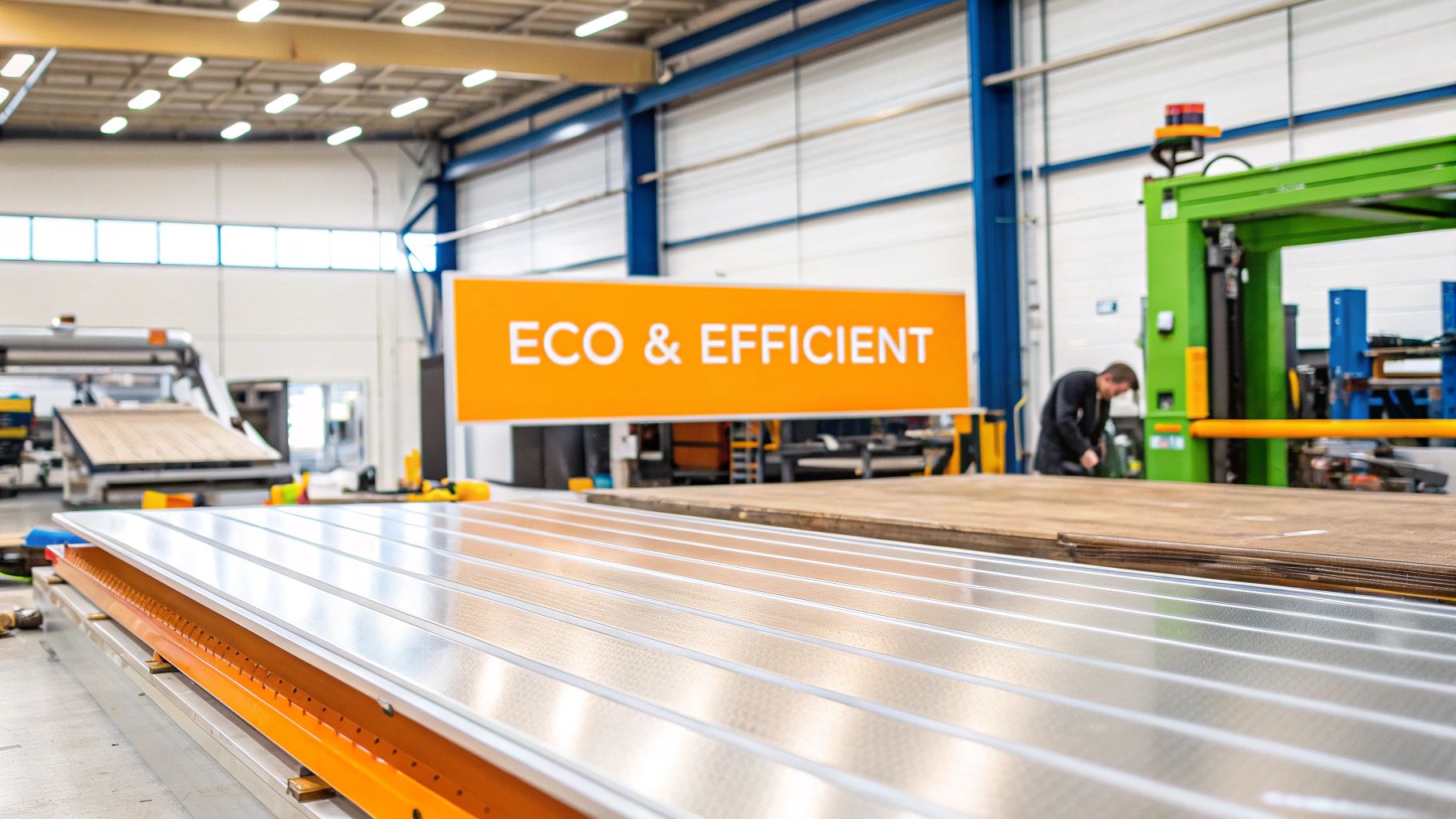
미래 지향적인 기업들은 경쟁 우위를 위해 레이저 녹 제거를 핵심 프로세스에 통합하고 있습니다. 이 섹션에서는 다양한 산업이 이 기술을 사용하여 효율성을 높이고, 비용을 절감하며, 우수한 결과를 달성하는 방법을 탐구합니다.
자동차: 정밀 표면 준비
자동차 산업에서 레이저 녹 제거는 표면 준비를 혁신하고 있습니다. 용접이나 도장 전에 깨끗한 표면이 필수적입니다. 레이저 시스템은 미세한 정밀도를 제공하여 녹과 오염 물질을 제거하면서도 기본 금속을 손상시키지 않습니다. 이는 더 강한 용접과 완벽한 도장 접착으로 이어집니다. 이러한 정밀한 청소는 전기차 배터리의 구성 요소를 준비하는 데에도 필수적입니다.
이 과정은 이러한 배터리의 수명과 성능을 보장하는 데 특히 중요합니다.
항공우주: 대체 불가능한 구성 요소 유지 관리
항공우주 산업은 필수 구성 요소를 유지하기 위해 레이저 녹 제거에 의존하며, 이들 구성 요소는 종종 특수 합금으로 제작됩니다. 이러한 부품을 교체하는 것은 비용이 많이 들고 세심한 관리가 필요합니다. 전통적인 방법은 이러한 민감한 재료를 손상시킬 위험이 있습니다. 레이저 청소는 비마모성 대안을 제공합니다. 또한 역사적인 항공기를 복원하는 데 매우 귀중하며, 원래 구조에 영향을 주지 않고 부식을 부드럽게 제거합니다.
역사적 무결성을 보존하는 것은 레이저 기술의 중요한 이점입니다.
해양: 끊임없는 부식과의 전투
해운 회사들은 가혹한 해양 환경으로 인해 부식과 끊임없이 싸우고 있습니다. 레이저 녹 제거는 주요 분해 없이 특정 영역의 녹을 목표로 하는 정밀한 솔루션을 제공합니다. 이는 가동 중지 시간과 유지 보수 비용을 최소화하여 선박과 해양 플랫폼의 수명을 연장합니다.
감소된 다운타임은 해양 운영에 대한 상당한 비용 절감으로 이어집니다.
응용 프로그램 확장 및 시장 성장
레이저 청소 시장은 다양한 분야에서 확장되고 있으며, 그 중요성이 커지고 있습니다. 자동차 분야에서는 타이어 금형 청소와 브레이크 라인 장식에 널리 사용됩니다. 레이저 청소는 전기차의 배터리 구성 요소 준비와 같은 정밀 작업에 필수적입니다. 인프라 유지 관리 또한 주요 성장 분야로, 교량 및 철도 유지 보수에 응용됩니다. Mordor Intelligence는 이 성장하는 시장에 대한 추가 통찰력을 제공합니다. 구조를 보존하고 효율적으로 표면을 준비하는 레이저의 능력은 내구성과 정밀성이 중요한 곳에서 필수적입니다.
구현 과제 및 예상치 못한 장점
레이저 녹 제거를 구현하는 데는 여러 가지 도전 과제가 있습니다. 초기 장비 투자 비용이 상당할 수 있습니다. 그러나 장기적인 이점이 종종 초기 비용을 초과합니다. 예상치 못한 장점으로는 노동 시간 감소와 자재 낭비 감소가 자주 포함됩니다. 전통적인 방법에서 발생하는 유해 폐기물을 제거하는 것도 또 다른 장점입니다.
이러한 결합된 이점은 보다 효율적이고 환경 친화적인 운영에 기여합니다.
측정 가능한 개선 및 환경 영향
산업 리더들은 효율성과 환경 책임 모두에서 측정 가능한 이익을 관찰하고 있습니다. 레이저 녹 제거의 정밀성은 자재 낭비를 최소화하고, 에너지 사용을 줄이며, 강한 화학 물질 사용을 감소시킵니다. 이러한 요소들은 수익성을 개선하고 보다 지속 가능한 관행에 기여합니다. 일부 기업들은 레이저 녹 제거를 채택한 후 환경 발자국이 현저히 줄어들었다고 보고하며, 이는 브랜드 이미지 향상과 증가하는 규제 요구 사항을 충족하는 데 도움이 됩니다. 향상된 부품 품질과 연장된 수명은 추가적인 장기 절약으로 이어집니다. 레이저 녹 제거를 수용함으로써 기업들은 단순히 운영을 개선하는 것이 아니라, 보다 지속 가능하고 효율적인 미래에 투자하고 있습니다.
레이저 녹 제거 성장 파도 활용하기
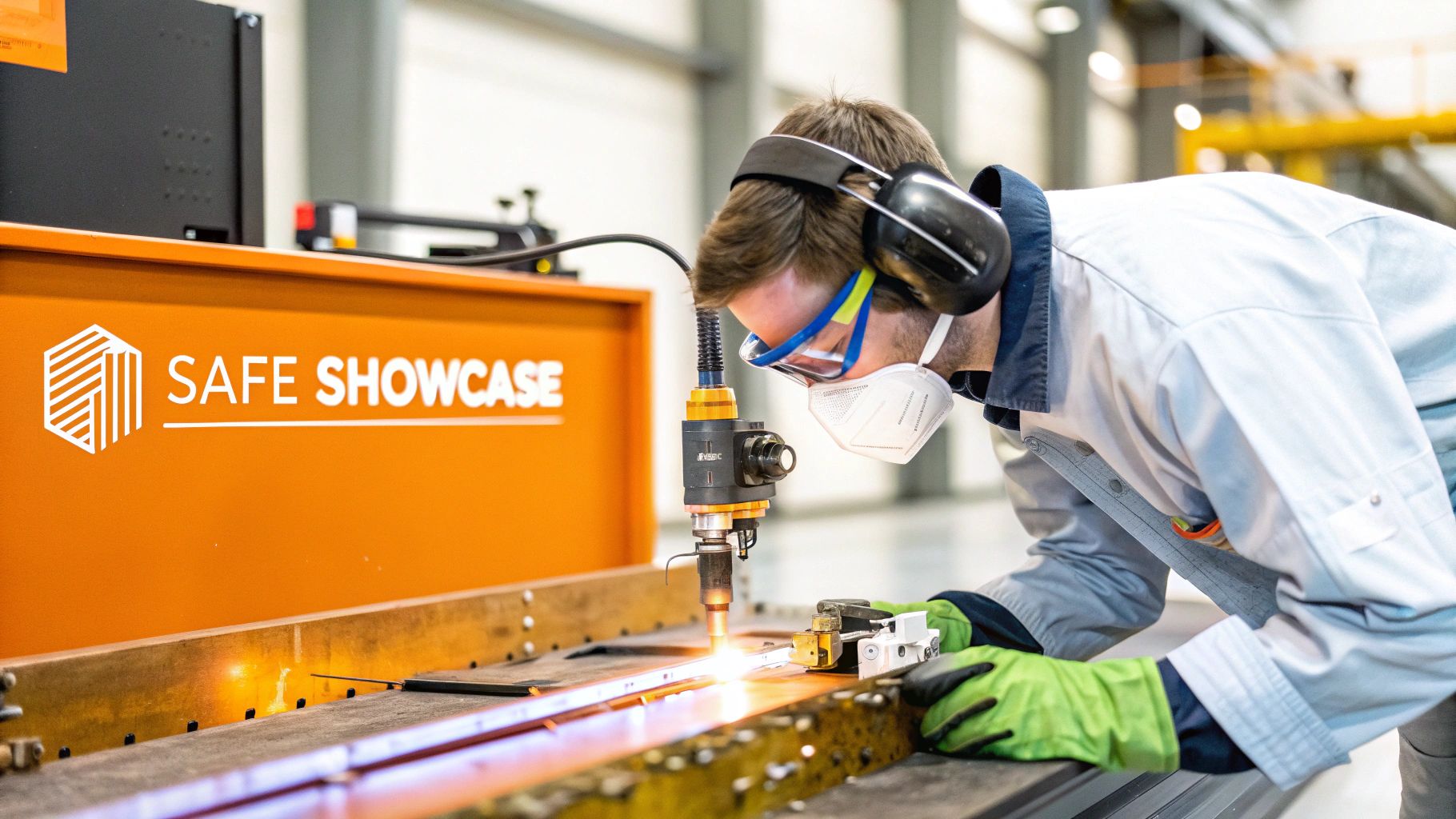
스마트 비즈니스는 레이저 녹 제거의 잠재력을 보고 있습니다. 이 섹션에서는 시장의 빠른 성장에 대해 다루고, 채택의 지역적 차이를 탐구하며, 기술이 이러한 시스템을 더 저렴하게 만드는 방법을 살펴봅니다. 이러한 트렌드를 따라가는 것은 경쟁력을 유지하는 데 핵심입니다.
시장 세분화 폭발
레이저 녹 제거 시장은 여러 산업에서 급성장하고 있습니다. 자동차 및 전자 제조업이 선두에 서 있으며, 정밀하고 효율적인 청소를 추구하고 있습니다. 이러한 성장은 용접 및 도장 전에 고급 표면 준비의 필요성에 의해 촉진되고 있습니다. 복원된 클래식 자동차와 빈티지 상품에 대한 수요 증가도 중요한 역할을 하고 있습니다.
이 증가하는 수요는 레이저 녹 제거 서비스를 제공하는 기업들에게 기회를 열어줍니다.
지역 채택 동향
레이저 녹 제거 채택은 전 세계적으로 균일하지 않습니다. 북미는 주요 산업의 조기 채택으로 인해 시장을 선도하고 있습니다. 그러나 아시아-태평양 지역은 가장 빠른 성장을 보일 것으로 예상됩니다. 이는 중국, 일본, 한국과 같은 국가에서의 강력한 산업 인프라와 엄격한 환경 규제에 기인합니다.
다음 표는 지역 시장 역학에 대한 심층 분석을 제공합니다:
레이저 녹 제거 시장 지역별 성장
시장 규모, 성장률 및 다양한 글로벌 지역에서의 주요 응용 프로그램 분석
| 지역 | 시장 규모 | 연평균 성장률 | 주요 산업 | 성장 동인 |
|---|---|---|---|---|
| 북아메리카 | 우성 | 보통의 | 자동차, 항공우주 | 조기 채택, 자동화 |
| 아시아 태평양 | 빠르게 성장하다 | 제일 높은 | 전자기기, 제조 | 산업 성장, 규제 |
| 유럽 | 꾸준한 성장 | 보통의 | 자동차, 산업 | 환경 문제, 혁신 |
| 세계의 나머지 | 떠오르는 | 보통의 | 다양한 | 인식 증가, 인프라 개발 |
이 표는 시장 규모, 예상 성장 및 수요를 주도하는 주요 산업의 지역별 차이를 요약합니다. 이러한 역학을 이해하는 것은 새로운 시장으로 확장하려는 기업에 필수적입니다.
전 세계 레이저 청소 시장, 즉 레이저 녹 제거를 포함한 시장은 2023년에 6.6억 달러로 평가되었습니다. 2032년까지 11.5억 달러에 이를 것으로 예상되며, CAGR 6.36%의 성장률을 보일 것으로 전망됩니다. 이러한 확장은 환경 지속 가능성에 대한 강조가 증가하고 있기 때문입니다. 더 많은 통계는 Straits Research에서 확인할 수 있습니다.
기술 개선 및 접근성
기술 발전으로 레이저 녹 제거 시스템이 중소기업에 더 접근 가능해졌습니다. 더 작고 저렴한 시스템이 이제 제공되어 진입 장벽이 낮아졌습니다. 개선된 사용자 인터페이스와 자동화는 운영을 간소화하여 전문 교육이 덜 필요하게 합니다.
이러한 발전은 기술을 더 넓은 범위의 기업들이 접근할 수 있도록 하여, 그들이 그 혜택을 누릴 수 있게 하고 있습니다.
규제 변화 및 시장 기회
환경 친화적인 관행을 촉진하는 규정은 레이저 녹 제거로의 전환을 가속화하고 있습니다. 화학 폐기물 처리 및 근로자 안전에 대한 stricter 규정은 전통적인 방법을 덜 매력적으로 만듭니다. 그 결과, 깨끗하고 안전한 대안인 레이저 녹 제거가 환경적으로 민감한 분야에서 주목받고 있습니다.
이러한 규제 변화는 기업들이 레이저 기술로 전환하도록 유도합니다.
산업 채택 일정 및 경쟁 우위
입양 일정 이해는 전략적 계획에 매우 중요합니다. 자동차 및 항공우주 산업의 초기 수용자들은 이미 품질 향상과 비용 절감과 같은 상당한 이점을 누리고 있습니다. 해양 및 건설과 같은 다른 산업들도 더 큰 효율성과 지속 가능성의 잠재력을 인식하기 시작하고 있습니다. 더 많은 정보를 원하시면 Laser Podcast를 확인해 보세요.
레이저 녹 제거를 도입한 경쟁자들에 뒤처지면 시장 점유율 손실과 수익 감소로 이어질 수 있습니다. 산업 동향과 도입 일정에 대한 정보를 유지하는 것은 이 확장하는 시장에서 기업이 성공하는 데 도움이 될 것입니다.
완벽한 레이저 녹 제거 시스템 선택하기
레이저 녹 제거 시스템은 부식을 처리하는 강력한 방법을 제공하지만, 모든 시스템이 동일하게 제작된 것은 아닙니다. 올바른 선택을 하는 것은 시간과 돈을 낭비하지 않기 위해 매우 중요합니다. 이 가이드는 고려해야 할 주요 요소를 깊이 있게 다루며, 마케팅 과대 광고를 넘어 실용적인 조언을 제공합니다.
레이저 종류 및 재료 호환성
첫 번째 단계는 사용 가능한 다양한 레이저 유형을 이해하는 것입니다. 파이버 레이저, CO2 레이저, 그리고 고체 레이저는 각각의 강점과 약점이 있습니다. 파이버 레이저는 1064nm 파장을 가지고 있어 금속 응용 분야에서 자주 사용됩니다. 이들은 강철 및 알루미늄과 같은 일반 재료에서 녹을 제거하는 데 뛰어납니다. 파이버 레이저는 효율성과 컴팩트한 크기로도 잘 알려져 있습니다. 반면에 CO2 레이저는 유기 재료에 더 적합합니다. 고체 레이저는 더 넓은 범위의 응용 분야에서 더 많은 다재다능성을 제공합니다.
예를 들어, 섬유 레이저는 자동차 부품에서 녹을 제거하는 데 완벽할 수 있는 반면, CO2 레이저는 섬세한 역사적 유물을 청소하는 데 더 적합할 수 있습니다. 올바른 레이저 유형을 선택하는 것은 성공적인 녹 제거의 기초입니다.
전원 사양: 귀하의 요구를 충족합니다
레이저 출력은 와트로 측정되며, 중요한 요소입니다. 출력이 높을수록 녹 제거가 더 빠르지만, 그만큼 아래의 재료를 손상시킬 위험도 커집니다. 출력이 부족한 시스템은 두꺼운 녹층을 효과적으로 제거하는 데 어려움을 겪을 것입니다. 일반적으로 다루는 녹의 종류와 두께를 신중하게 평가하여 애플리케이션에 필요한 출력 수준을 결정하십시오.
가벼운 표면 녹을 위해 설계된 시스템은 중대한 산업 부식에 효과적이지 않습니다. 최적의 결과를 위해 레이저의 출력을 귀하의 특정 요구 사항에 맞추는 것이 중요합니다.
자동화 기능: 생산성 향상
자동화 기능은 생산성을 크게 향상시킬 수 있습니다. 패턴 인식 시스템은 레이저가 부품의 윤곽을 자동으로 추적할 수 있게 하여 균일한 청소를 보장합니다. 더 복잡한 작업의 경우, 로봇 팔을 통합하면 전체 프로세스를 자동화할 수 있어 수작업을 대폭 줄이고 처리량을 증가시킬 수 있습니다. 로봇 팔은 높은 유연성과 정밀도를 제공합니다. 그러나 자동화 수준은 복잡성과 비용이 다양하게 나타납니다.
비용과 워크플로우에 필요한 자동화 수준 간의 균형을 고려하세요. 작은 작업장은 기본적인 패턴 인식만 필요할 수 있지만, 더 큰 산업 환경에서는 완전 자동화된 로봇 시스템이 정당화될 수 있습니다. 당신이 관심을 가질 만한 내용: 레이저 응용 프로그램 마스터하기.
소유 비용: 구매 가격을 넘어서
초기 구매 가격은 퍼즐의 한 조각에 불과합니다. 유지보수 비용, 교체 부품 및 서비스 계약을 포함하여, 장기적인 비용에 상당한 영향을 미칠 수 있습니다. 운영자 교육은 또 다른 중요한 투자입니다. 잘 훈련된 운영자는 시스템을 최대한 활용하면서 손상이나 오류의 위험을 최소화할 수 있습니다. 마지막으로, 시스템이 제공하는 생산성 향상을 평가하십시오. 더 빠른 청소와 재작업 감소는 귀하의 수익을 크게 개선할 수 있습니다.
유지보수, 교육 및 생산성 향상 가능성을 고려하여 실제 소유 비용을 계산하십시오. 포괄적인 비용 분석은 시간이 지남에 따라 최고의 가치를 제공하는 시스템으로 안내할 것입니다.
레이저 녹 제거의 미래가 지금 여기에 있습니다.
레이저 녹 제거에서 가장 흥미로운 발전이 지금 일어나고 있습니다. 기술 개발자 및 초기 사용자와의 대화는 이 기술의 잠재력을 재편하는 혁신적인 발견을 보여줍니다.
AI 기반 최적화
녹을 제거할 뿐만 아니라 기술을 향상시키는 레이저 시스템을 상상해 보세요. AI 기반 시스템이 등장하여 자동으로 녹의 종류를 식별하고 레이저 매개변수를 실시간으로 조정합니다. 이 스마트 자동화는 최대 효율성과 최소 자재 손실을 위해 청소 프로세스를 최적화합니다.
예를 들어, 시스템은 고집 센 부식 패치를 인식하고 해당 영역에서 레이저의 출력을 자동으로 증가시킬 수 있습니다. 이러한 실시간 적응은 레이저 녹 제거의 전반적인 효과를 크게 향상시킵니다.
휴대용 레이저 솔루션: 접근성 확대
전통적인 레이저 녹 제거 시스템은 다루기 불편하고 이동하기 어려울 수 있습니다. 그러나 새로운 휴대용 솔루션은 이 기술을 이전에 접근할 수 없었던 장소로 가져오고 있습니다. 대형 역사적 기념물을 복원하거나 현장에서 선체를 수리하는 것을 생각해 보세요.
이 휴대용 시스템은 많은 가능성을 열어주어 레이저 녹 제거를 더 다양한 응용 분야에 적합한 솔루션으로 만듭니다. 이러한 접근성 증가는 현장 수리를 가능하게 하여 가동 중지 시간과 운송 비용을 줄입니다.
산업 4.0 통합: 가동 시간 극대화
레이저 녹 제거 시스템을 산업 사물 인터넷 (IIoT)와 통합하는 것은 또 다른 중요한 발전입니다. 이 산업 4.0 통합은 시스템 성능을 모니터링하고 잠재적인 문제를 예측함으로써 예측 유지보수를 가능하게 합니다.
예를 들어, 시스템은 레이저 출력의 약간의 감소를 감지할 수 있으며, 이는 레이저 소스에 문제가 있음을 나타냅니다. 이를 통해 사전 유지보수가 가능해져 가동 중단 시간을 최소화하고 운영 효율성을 극대화할 수 있습니다. 원격 운영 기능은 실시간 모니터링 및 제어를 가능하게 하여, 심지어 원거리에서도 가능합니다.
지속 가능성과 순환 경제
레이저 녹 제거는 이미 전통적인 방법에 비해 상당한 환경적 이점을 제공합니다. 그러나 지속 가능성에 대한 집중은 혁신을 더욱 촉진하고 있습니다. 일부 기업은 레이저 청소 과정에서 발생하는 녹 부산물을 포집하고 재활용함으로써 순환 경제 원칙을 구현하고 있습니다.
이것은 폐기물을 줄이고 새로운 자원 흐름을 창출합니다. 검증된 탄소 발자국 감소는 브랜드 이미지를 강화하고 환경 규제를 준수하는 기업에게 점점 더 중요해지고 있습니다. 지속 가능성에 대한 이러한 약속은 환경에 이익을 주고 기업의 명성을 높입니다.
레이저 기술을 탐험할 준비가 되셨나요? Laser Insights China는 레이저 녹 제거를 포함한 레이저 응용 분야의 최신 발전에 대한 포괄적인 정보를 제공합니다. Laser Insights China를 방문하여 표면 처리의 미래와 그것이 귀하의 비즈니스에 어떻게 도움이 될 수 있는지에 대해 더 알아보세요.
